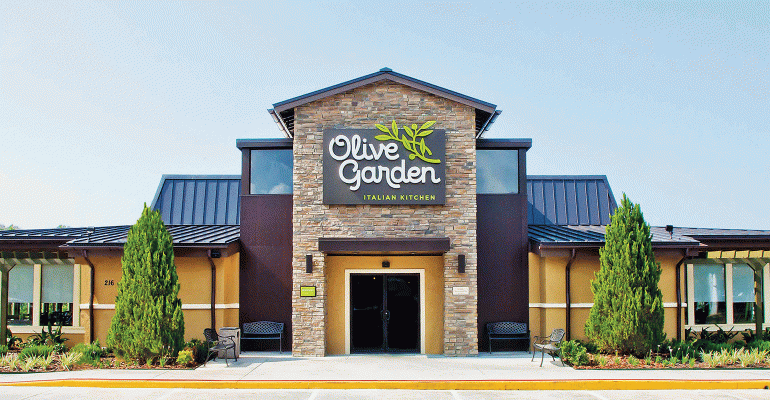Consumers’ need for convenience is driving casual-dining chains to consider delivery, but the high cost of third-party companies pose a high hurdle, the CEO of Darden Restaurants Inc. said Tuesday.
“The consumer is still looking for convenience,” said Gene Lee, CEO of Orlando, Fla.-based Darden, in a second-quarter conference call with analysts. “We've got some brands that really can satisfy that, especially Olive Garden. We've done a really great job with that. I think that that's probably a more permanent part of our equation today.”
Lee said Darden is testing several ways to deliver its meals to the consumer and learning what works best.
“We believe that someone is going to rise up and create some scale in the space, and we'll watch those third-party deliverers,” he said. “We're also watching competitors that are doing it themselves. We have a small test that we're doing ourselves.”
And while Lee said he was bullish on delivery trends in general, third-party delivery remained expensive. “We'll do it ourselves before we live with their economics,” he said, adding third-party delivery companies have not reached scale to keep the costs down.
“We're trying to understand their profit model,” he said, “and we're trying to understand our profit model doing it internally.”
Large-scale orders still make sense for the Olive Garden concept, he said.
“We are still very attracted to the large-party-delivery catering in Olive Garden, where our average order is over $300,” Lee said. “That makes a lot more sense for us to market and pursue than running around and delivery $10 entrées at this point in time. So for us it's a wait-and-see. We're very engaged in the process with all the third-party delivery companies. And we are very engaged with our own activity around that.”
The company, meanwhile, has seen its Olive Garden to-go sales increase 12 percent in the quarter, with units on average doing $500,000 in to-go orders and some units reaching $1 million, Lee said.
For the second quarter ended Nov.26, Darden reported profit increased 6.5 percent to $84.7 million, or 67 cents a share, up from $79.5 million, or 64 cents a share, in the same period last year.
Removing one-time costs and discontinued operations, earnings were 73 cents per share, beating expectations of 71 cents a share, as compiled by the website Earnings Whispers. At midday Tuesday, Darden’s stock was trading up more than $4.75 a share, or more than 5 percent over Monday’s close of $90.54.
Darden’s second-quarter sales were up 14.6 percent to $1.88 billion from $1.642 billion in the prior-year quarter.
Same-store sales at Darden casual-dining brands in the second quarter rose 3.1 percent and included:
- Olive Garden (849 units), up 3 percent.
- LongHorn Steakhouse (496 units), up 3.8 percent.
- Cheddar’s Scratch Kitchen (153 units), down 2 percent.
- Yard House (68 units), up 2 percent.
- Capital Grille (57 units), up 3.8 percent.
- Bahama Breeze (39 units), up 2.5 percent.
- Seasons 52 (41 units), down 0.25 percent.
- Eddie V’s (19 units), up 6.8 percent.
Second-quarter sales growth was boosted by 11.5 percent with the addition of Cheddar’s, which Darden acquired in April.
Ricardo Cardenas, Darden’s chief financial officer, said the integration of the 153 Cheddar’s units into the Darden portfolio was going faster than anticipated.
Lee said the integration process was peaking as the company transitioned Cheddar’s distributors, produce suppliers, small-ware providers, payroll and benefits. Point-of-sale systems are being converted in 10 restaurants per week, he said, which includes two weeks of training prior to conversion.
“It is our intent to integrate Cheddar's and the two acquired franchise systems as fast as possible in order to position the brand to take advantage of the scale, synergies and other benefits of the Darden infrastructure,” Lee said. Two franchise groups had owned and operated 54 of the Cheddar’s restaurants, with one group being bought out before the sale and the second that Darden purchased after the acquisition.
The integration “is having a short-term negative impact on sales momentum,” Lee said, “but we believe the long-term benefit will far outweigh the short-term impact.”
He added that the Cheddar’s brand, with a check average of about $14, “is a way for people to trade into casual dining.”
Lee said Darden also believes Cheddar's will benefit from staff-retention improvements. “Right now their employee retention system is about the average of the industry, and we believe that we can take them from 120 percent team-member turnover down to our normal 70,” he said. “That's going to have a huge impact on the overall operation.”
Operations have also been improved at LongHorn Steakhouse with a simplification of the menu, reducing complexity in the kitchen and reducing stock-keeping units by reducing quarterly menu introductions. The number of menu items has been trimmed between 25 percent 30 percent, Lee said.
“Longhorn historically has been a high food cost/low labor cost operation,” Lee said. “And we have simplified that operation to be able to bring the labor cost down and increase the productivity while improving the overall quality of the food product. And even as much as we reduced it already, I think they're still further reductions to be done in the Longhorn menu to improve and simplify the operation. Those are very small kitchens that have to stay simple in order to be able to cook great steaks in a timely manner.
Darden operates 1,722 restaurants across its eight brands.
Contact Ron Ruggless at [email protected]
Follow him on Twitter: @RonRuggless





